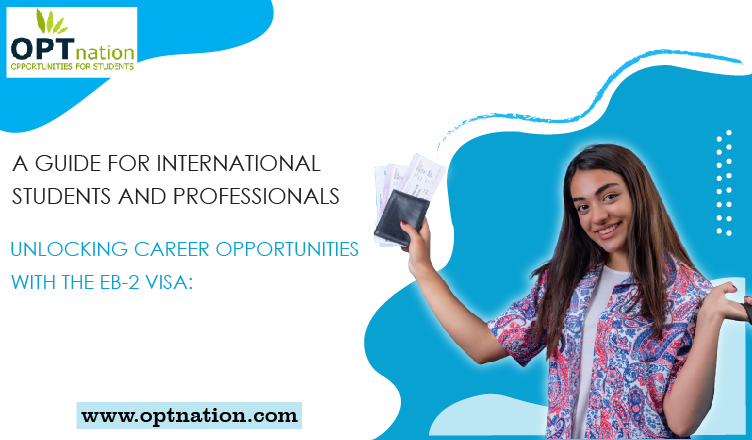For international students in the United States, Optional Practical Training (OPT) is often the first significant step toward gaining work experience. But OPT is temporary, and transitioning to a long-term career can be challenging. Enter the EB-2 visa solution that offers permanent residency and broad career opportunities for skilled professionals.
This guide explores how the EB-2 visa serves as an excellent option for international students and professionals, complementing other employment visa categories such as H1B. Whether you’re completing OPT or planning your next career move, understanding the EB-2 visa can make all the difference.
Understanding the EB-2 Visa
The EB-2 visa, or Employment-Based Second Preference visa, is designed for individuals with exceptional skills or advanced degrees who wish to live and work in the United States. There are two main categories under the EB-2 visa:
- Advanced Degree Professionals: Applicants must have a degree beyond a bachelor’s (or equivalent) and a job offer that matches their qualifications.
- Exceptional Ability: This applies to individuals with demonstrated expertise in the sciences, arts, or business that exceeds the usual standards in their field.
Compared to OPT, CPT, or even H1B visas, the EB-2 visa offers a stable path to permanent residence. It does not involve a lottery system and allows the applicant to transition to a green card, ensuring long-term job security.
Why International Students Should Consider the EB-2 Visa
OPT and H1B visas provide valuable opportunities for international students, but they come with limitations. OPT is temporary, lasting up to 12 months (or 36 months with STEM extensions), while the H1B visa is subject to an annual lottery. These limitations can create uncertainty for individuals seeking career stability.
The EB-2 visa addresses these challenges. It provides:
- A permanent solution: Unlike OPT or H1B, the EB-2 visa leads directly to permanent residence.
- Freedom of Choice: Once granted, green card holders can work for multiple employers or even start their own businesses.
- Security for the future: Permanent residency allows visa holders to plan for family sponsorship and other long-term goals.
For students completing OPT, the EB-2 visa is a logical step forward, offering the opportunity to build on their education and work experience without time constraints.
EB-2 Visa Eligibility and Requirements
To qualify for the EB-2 visa, applicants must meet specific requirements under either the Advanced Degree or Exceptional Ability categories.
Advanced Degree
- Holders of a Master’s, Doctoral, or equivalent degree.
- The position applied for must require an advanced degree.
Exceptional ability
- Demonstrated expertise in a specific field through evidence such as awards, certifications, or professional recognition.
National Interest Waiver (NIW) The NIW allows applicants to waive the employer sponsorship requirement if their work is deemed to be in the U.S. national interest. This pathway is particularly useful for individuals in the research, technology, or public health sectors.
Documentation Requirements
- Academic transcripts and degrees.
- Evidence of professional accomplishments (awards, publications, endorsements).
- A detailed resume highlighting relevant experience.
The EB-2 Visa Process
The EB-2 visa application process involves several critical steps:
- Job Offer or NIW
Employer-sponsored applicants must have a job offer from a U.S.-based organization.
NIW applicants may self-petition by demonstrating that their work will benefit the country. - Labor Certification (PERM)
Required for employer-sponsored petitions. Employers must show that there are no qualified U.S. workers available for the position. - Filing Form I-140
This petition officially requests the EB-2 classification. Corroborating evidence, including qualifications and job offer details, must be submitted. - Adjustment of Status or Consular Processing
If in the U.S., applicants file Form I-485 to adjust their status. Outside the U.S., applicants complete consular processing to obtain a green card.
Timeline and Cost
- Typical processing times range from 6-12 months, depending on factors such as PERM certification and USCIS backlogs.
- Costs include employer fees, form filing fees, and potential legal fees for document preparation.
How OPT Professionals Can Transition to the EB-2 Visa
For those currently in OPT, the EB-2 visa offers a clear path to permanent residence. Here’s how:
- Leverage OPT Experience: Use your OPT period to gain relevant work experience in your field and build a stronger case for your EB-2 petition.
- Work with employers: If sponsored, discuss the possibility of converting to EB-2 early in your employment.
- Consider NIW: If your work aligns with national interests, such as innovative technology or health care solutions, self-petitioning through NIW may be an ideal choice.
Challenges and Tips for a Successful EB-2 Application
The EB-2 visa application process can be complex. Common challenges include
- Navigating labor certification requirements.
- Convincing employers to invest in sponsorship.
- Demonstrate exceptional ability or national interest for NIW.
Tips for Success
- Build a Strong Portfolio: Highlight relevant accomplishments, certifications, and academic work.
- Seek Expert Guidance: Immigration attorneys can help navigate the paperwork and streamline the process.
- Be Proactive: Start preparing early, especially if you are transitioning from OPT or H1B.
Success Stories: EB-2 Visa Holders in the Tech Industry
Many international students in the technology industry have successfully transitioned from OPT to the EB-2 visa. For example, one software engineer working under OPT used his experience in AI development to qualify for NIW. Another candidate used his advanced degree in cybersecurity to secure an employer-sponsored EB-2 visa.
Industries such as IT, engineering, and healthcare are particularly well-suited for EB-2 petitions due to the high demand for skilled professionals.
The bottom line
The EB-2 visa offers international students and professionals a pathway to long-term stability and career growth in the United States. Unlike temporary options such as OPT and H1B, the EB-2 visa leads directly to permanent residency, providing freedom and security. By understanding the requirements and preparing thoroughly, you can unlock a future of opportunity.
For those ready to take the next step, the EB-2 visa is more than just a legal pathway-it’s a chance to build a life and career in the United States.

